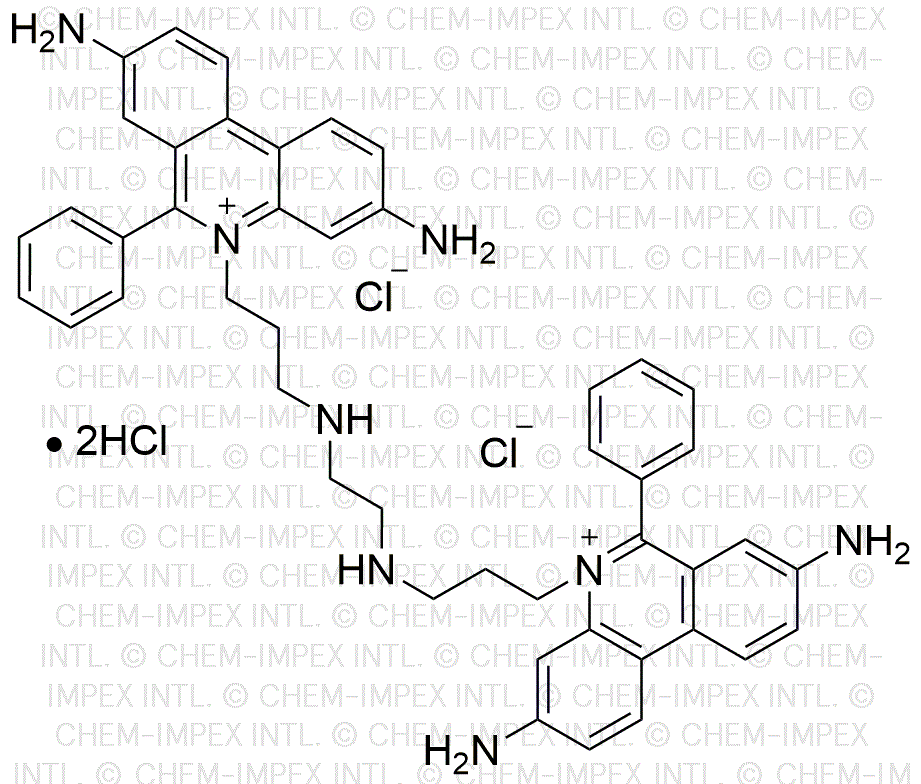Ethidium homodimer is widely utilized in research focused on:
- Nucleic Acid Staining: This compound is primarily used in molecular biology for staining DNA in gels. Its ability to intercalate between base pairs allows for easy visualization of nucleic acids during electrophoresis, making it essential for researchers analyzing genetic material.
- Cell Viability Assays: Ethidium homodimer is employed in assays to determine cell viability. It selectively enters dead or dying cells, allowing researchers to differentiate between live and dead cells, which is crucial in drug testing and toxicity studies.
- Fluorescence Microscopy: In microscopy applications, this chemical enhances the visualization of cellular structures. Its fluorescent properties enable researchers to study cellular processes and dynamics in real-time, providing insights into cellular functions.
- Apoptosis Studies: The compound is used to investigate programmed cell death (apoptosis). By assessing the uptake of ethidium homodimer, researchers can determine the integrity of cell membranes, which is vital for understanding cancer and other diseases.
- Genetic Research: Ethidium homodimer plays a role in various genetic studies, including PCR and cloning. Its effectiveness in detecting DNA fragments makes it a valuable tool for genetic engineering and molecular cloning applications.
Informations générales
Propriétés
Sécurité et réglementation
Applications
Ethidium homodimer is widely utilized in research focused on:
- Nucleic Acid Staining: This compound is primarily used in molecular biology for staining DNA in gels. Its ability to intercalate between base pairs allows for easy visualization of nucleic acids during electrophoresis, making it essential for researchers analyzing genetic material.
- Cell Viability Assays: Ethidium homodimer is employed in assays to determine cell viability. It selectively enters dead or dying cells, allowing researchers to differentiate between live and dead cells, which is crucial in drug testing and toxicity studies.
- Fluorescence Microscopy: In microscopy applications, this chemical enhances the visualization of cellular structures. Its fluorescent properties enable researchers to study cellular processes and dynamics in real-time, providing insights into cellular functions.
- Apoptosis Studies: The compound is used to investigate programmed cell death (apoptosis). By assessing the uptake of ethidium homodimer, researchers can determine the integrity of cell membranes, which is vital for understanding cancer and other diseases.
- Genetic Research: Ethidium homodimer plays a role in various genetic studies, including PCR and cloning. Its effectiveness in detecting DNA fragments makes it a valuable tool for genetic engineering and molecular cloning applications.
Documents
Fiches de données de sécurité (FDS)
La FDS fournit des informations de sécurité complètes sur la manipulation, le stockage et l’élimination du produit.
Spécifications du produit (PS)
Le PS fournit une description complète des propriétés du produit, notamment sa composition chimique, son état physique, sa pureté et les exigences de stockage. Il détaille également les plages de qualité acceptables et les applications prévues du produit.
Certificats d'analyse (COA)
Recherchez des certificats d'analyse (COA) en saisissant le numéro de lot du produit. Les numéros de lot et de lot se trouvent sur l'étiquette d'un produit, après les mots « Lot » ou « Lot de fabrication ».
Numéro de catalogue
Numéro de lot/série
Certificats d'origine (COO)
Ce certificat d'exploitation confirme le pays dans lequel le produit a été fabriqué, et détaille également les matériaux et composants utilisés et s'il est issu de sources naturelles, synthétiques ou autres sources spécifiques. Ce certificat peut être requis pour les douanes, le commerce et la conformité réglementaire.
Numéro de catalogue
Numéro de lot/série
Fiches de données de sécurité (FDS)
La FDS fournit des informations de sécurité complètes sur la manipulation, le stockage et l’élimination du produit.
DownloadSpécifications du produit (PS)
Le PS fournit une description complète des propriétés du produit, notamment sa composition chimique, son état physique, sa pureté et les exigences de stockage. Il détaille également les plages de qualité acceptables et les applications prévues du produit.
DownloadCertificats d'analyse (COA)
Recherchez des certificats d'analyse (COA) en saisissant le numéro de lot du produit. Les numéros de lot et de lot se trouvent sur l'étiquette d'un produit, après les mots « Lot » ou « Lot de fabrication ».
Numéro de catalogue
Numéro de lot/série
Certificats d'origine (COO)
Ce certificat d'exploitation confirme le pays dans lequel le produit a été fabriqué, et détaille également les matériaux et composants utilisés et s'il est issu de sources naturelles, synthétiques ou autres sources spécifiques. Ce certificat peut être requis pour les douanes, le commerce et la conformité réglementaire.


